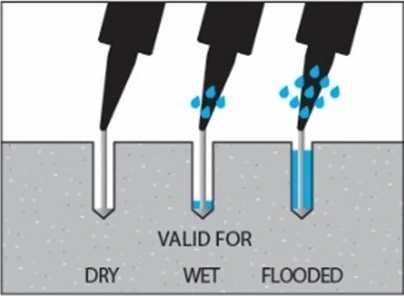When installing anchors, depending on the operating principle, the condition of the hole can influence the performance of the product. First, let´s define the three conditions stated in the regulations:

- Dry hole: this a hole in which an anchor is installed in non-existent humidity conditions.
- Wet hole: this is a hole in which an anchor is installed where there are existing humidity conditions. This means that inside the hole feels wet to the touch. We usually come across this situation during the drying process of a hole or when it has been exposed to light rain.
- Flooded hole: this is a hole in which an anchor is installed in conditions of total humidity, that is, the hole is full of water (not to be confused with a submerged hole). This usually occurs when the installation is carried out during heavy rain or after a day of intense rain, the installer may find the hole partially or completely full of water.
Once we know how to differentiate between the hole conditions, we need to determine how they influence the performance of the anchors. It has no influence on mechanical anchors because all of them, or at least most, are approved for the three conditions described above without influencing performance in any way. In contrast, it is highly relevant for the installation and curing of chemical anchors.
Certain products on the market may not be approved for installation in flooded holes, which means that they can´t be used in these conditions. With INDEX, the only chemical anchor not approved for flooded holes is the MOPURE.
However, even if the product is approved for all three conditions, its performance may be reduced when installed in flooded holes. This condition usually affects the characteristic adhesion resistance or the installation safety coefficient of the product. At INDEX, the only chemical anchor affected by this casuistry is MO-H, where the installation safety coefficient shifts from 1.8 to 2.1.
Finally, another aspect to take into account is that on the market we tend to find products with curing times that are affected when installations are carried out in flooded holes. These times are usually doubled. Fortunately, no INDEX product has curing times affected by hole conditions; like all chemical anchors, they are only affected by the temperature of the base material.
Ultima revisione: FAQ18 rev0

